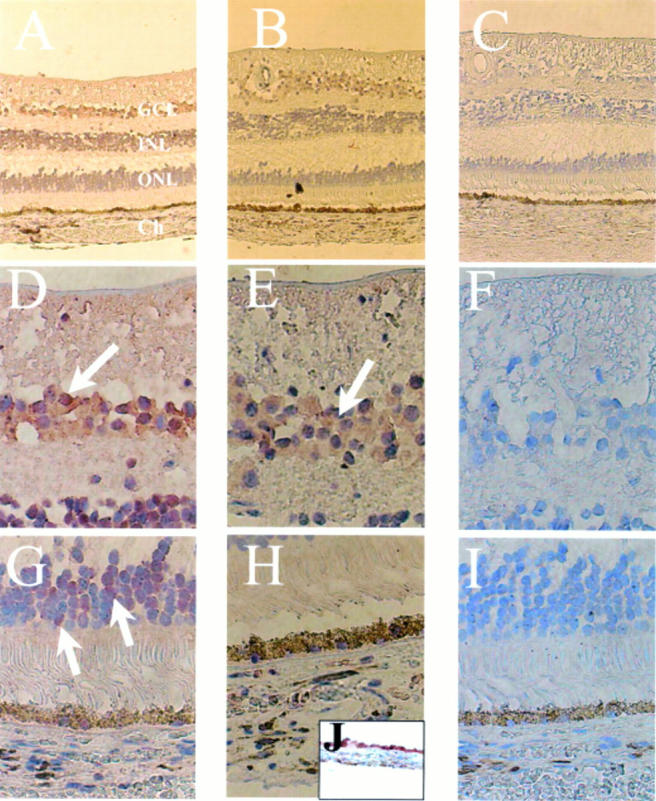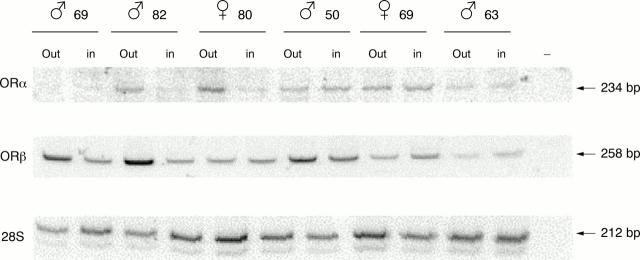Abstract
BACKGROUND/AIMS—Recent studies have demonstrated the existence of two oestrogen receptor subtypes α (ORα) and β (ORβ) with significant differences of expression among organs. Since important pathologies of human eye could be linked to hormonal status, the expression of ORβ in ocular posterior segment was sought. METHODS—Immunohistochemical localisation of ORβ and ORα protein and detection of OR mRNAs by reverse transcription-polymerase chain reaction (RT-PCR) were performed in macular and extramacular regions of the retina and in the choroid on male and female donors eyes. RESULTS—ORβ protein was localised in the ganglion cell layer and in the choroid. At the transcriptional level, mRNA for ORβ and for ORα were both present. Local differences in the expression level were observed, however, suggesting the possibility of variation in the ratio of ORα v ORβ. CONCLUSIONS—The coexistence of two oestrogen receptor subtypes in the human ocular posterior segment raises acute questions about their potential physiological role, but offers a perspective for preferential targeting of a specific receptor subtype.
Full Text
The Full Text of this article is available as a PDF (271.6 KB).
Figure 1 .

Immunolocalisation of ORα (A, D, G) and ORβ (B, E, H) and negative controls (C, F, I) on paraffin sections of ocular posterior segment at low magnification (×100, A, B, C) or higher magnification (×400) focused either on ganglion cell layer (D, E, F), on the choroid-RPE complex (G, H, I), or selectively on the RPE (J). Note the staining of ORα (arrows) in all nuclear layers (A) and the concentration of ORβ (arrows) in ganglion cell layer (E) and in choroidal structures (H). Ch = choroid; ONL = outer nuclear layer; INL = inner nuclear layer; GCL = ganglion cell layer.
Figure 2 .
Human retina contained a band of oestrogen receptor α and β (relative molecular mass of 67 kDa). Testis was used as a positive control, and the HT1080 cell line was negative.
Figure 3 .
Representative example of ORα and ORβ mRNA expression in the eye of various sex donors (age is given in years with sex symbol). Total RNA (approximately 10 ng) from the macular region (in) or from the peripheral retina (out) were submitted to RT-PCR as described in Materials and methods. The 28S rRNA (lower panel) is used to assess the total amount of RNA loaded.
Figure 4 .
ORα and ORβ mRNA expression in human retinas (R) and choroidal (Ch) regions of a representative couple of male and female donors. RT-PCR was performed as described in Materials and methods. The 28S rRNA is used to assess the total amount of RNA loaded.
Selected References
These references are in PubMed. This may not be the complete list of references from this article.
- Behl C., Widmann M., Trapp T., Holsboer F. 17-beta estradiol protects neurons from oxidative stress-induced cell death in vitro. Biochem Biophys Res Commun. 1995 Nov 13;216(2):473–482. doi: 10.1006/bbrc.1995.2647. [DOI] [PubMed] [Google Scholar]
- Benitez del Castillo J. M., del Rio T., Garcia-Sanchez J. Effects of estrogen use on lens transmittance in postmenopausal women. Ophthalmology. 1997 Jun;104(6):970–973. doi: 10.1016/s0161-6420(97)30198-5. [DOI] [PubMed] [Google Scholar]
- Bigsby R. M., Cardenas H., Caperell-Grant A., Grubbs C. J. Protective effects of estrogen in a rat model of age-related cataracts. Proc Natl Acad Sci U S A. 1999 Aug 3;96(16):9328–9332. doi: 10.1073/pnas.96.16.9328. [DOI] [PMC free article] [PubMed] [Google Scholar]
- Bourassa P. A., Milos P. M., Gaynor B. J., Breslow J. L., Aiello R. J. Estrogen reduces atherosclerotic lesion development in apolipoprotein E-deficient mice. Proc Natl Acad Sci U S A. 1996 Sep 17;93(19):10022–10027. doi: 10.1073/pnas.93.19.10022. [DOI] [PMC free article] [PubMed] [Google Scholar]
- Cavaney-Brooker D. M., Rakoczy P. E. Cloning of a major human retinal pigment epithelial lysosomal aspartic protease and mapping its transcriptional start sites. Curr Eye Res. 1999 Apr;18(4):310–318. doi: 10.1076/ceyr.18.4.310.5357. [DOI] [PubMed] [Google Scholar]
- Corder E. H., Saunders A. M., Strittmatter W. J., Schmechel D. E., Gaskell P. C., Small G. W., Roses A. D., Haines J. L., Pericak-Vance M. A. Gene dose of apolipoprotein E type 4 allele and the risk of Alzheimer's disease in late onset families. Science. 1993 Aug 13;261(5123):921–923. doi: 10.1126/science.8346443. [DOI] [PubMed] [Google Scholar]
- Cumming R. G., Mitchell P. Hormone replacement therapy, reproductive factors, and cataract. The Blue Mountains Eye Study. Am J Epidemiol. 1997 Feb 1;145(3):242–249. doi: 10.1093/oxfordjournals.aje.a009097. [DOI] [PubMed] [Google Scholar]
- Dubey R. K., Jackson E. K., Gillespie D. G., Zacharia L. C., Imthurn B., Keller P. J. Clinically used estrogens differentially inhibit human aortic smooth muscle cell growth and mitogen-activated protein kinase activity. Arterioscler Thromb Vasc Biol. 2000 Apr;20(4):964–972. doi: 10.1161/01.atv.20.4.964. [DOI] [PubMed] [Google Scholar]
- Fotsis T., Pepper M. S., Montesano R., Aktas E., Breit S., Schweigerer L., Rasku S., Wähälä K., Adlercreutz H. Phytoestrogens and inhibition of angiogenesis. Baillieres Clin Endocrinol Metab. 1998 Dec;12(4):649–666. doi: 10.1016/s0950-351x(98)80009-8. [DOI] [PubMed] [Google Scholar]
- Fotsis T., Pepper M., Adlercreutz H., Fleischmann G., Hase T., Montesano R., Schweigerer L. Genistein, a dietary-derived inhibitor of in vitro angiogenesis. Proc Natl Acad Sci U S A. 1993 Apr 1;90(7):2690–2694. doi: 10.1073/pnas.90.7.2690. [DOI] [PMC free article] [PubMed] [Google Scholar]
- Gonzalez I. L., Gorski J. L., Campen T. J., Dorney D. J., Erickson J. M., Sylvester J. E., Schmickel R. D. Variation among human 28S ribosomal RNA genes. Proc Natl Acad Sci U S A. 1985 Nov;82(22):7666–7670. doi: 10.1073/pnas.82.22.7666. [DOI] [PMC free article] [PubMed] [Google Scholar]
- Greene G. L., Gilna P., Waterfield M., Baker A., Hort Y., Shine J. Sequence and expression of human estrogen receptor complementary DNA. Science. 1986 Mar 7;231(4742):1150–1154. doi: 10.1126/science.3753802. [DOI] [PubMed] [Google Scholar]
- Hawk T., Zhang Y. Q., Rajakumar G., Day A. L., Simpkins J. W. Testosterone increases and estradiol decreases middle cerebral artery occlusion lesion size in male rats. Brain Res. 1998 Jun 15;796(1-2):296–298. doi: 10.1016/s0006-8993(98)00327-8. [DOI] [PubMed] [Google Scholar]
- Hayashi A., Weinberger A. W., Kim H. C., de Juan E., Jr Genistein, a protein tyrosine kinase inhibitor, ameliorates retinal degeneration after ischemia-reperfusion injury in rat. Invest Ophthalmol Vis Sci. 1997 May;38(6):1193–1202. [PubMed] [Google Scholar]
- Jaggers D. C., Collins W. P., Milligan S. R. Potent inhibitory effects of steroids in an in vitro model of angiogenesis. J Endocrinol. 1996 Sep;150(3):457–464. doi: 10.1677/joe.0.1500457. [DOI] [PubMed] [Google Scholar]
- Klaver C. C., Kliffen M., van Duijn C. M., Hofman A., Cruts M., Grobbee D. E., van Broeckhoven C., de Jong P. T. Genetic association of apolipoprotein E with age-related macular degeneration. Am J Hum Genet. 1998 Jul;63(1):200–206. doi: 10.1086/301901. [DOI] [PMC free article] [PubMed] [Google Scholar]
- Knouff C., Hinsdale M. E., Mezdour H., Altenburg M. K., Watanabe M., Quarfordt S. H., Sullivan P. M., Maeda N. Apo E structure determines VLDL clearance and atherosclerosis risk in mice. J Clin Invest. 1999 Jun;103(11):1579–1586. doi: 10.1172/JCI6172. [DOI] [PMC free article] [PubMed] [Google Scholar]
- Kobayashi K., Kobayashi H., Ueda M., Honda Y. Estrogen receptor expression in bovine and rat retinas. Invest Ophthalmol Vis Sci. 1998 Oct;39(11):2105–2110. [PubMed] [Google Scholar]
- Kuiper G. G., Enmark E., Pelto-Huikko M., Nilsson S., Gustafsson J. A. Cloning of a novel receptor expressed in rat prostate and ovary. Proc Natl Acad Sci U S A. 1996 Jun 11;93(12):5925–5930. doi: 10.1073/pnas.93.12.5925. [DOI] [PMC free article] [PubMed] [Google Scholar]
- Kuiper G. G., Lemmen J. G., Carlsson B., Corton J. C., Safe S. H., van der Saag P. T., van der Burg B., Gustafsson J. A. Interaction of estrogenic chemicals and phytoestrogens with estrogen receptor beta. Endocrinology. 1998 Oct;139(10):4252–4263. doi: 10.1210/endo.139.10.6216. [DOI] [PubMed] [Google Scholar]
- Majji A. B., Hayashi A., Kim H. C., Grebe R. R., de Juan E., Jr Inhibition of choriocapillaris regeneration with genistein. Invest Ophthalmol Vis Sci. 1999 Jun;40(7):1477–1486. [PubMed] [Google Scholar]
- Makela S, Davis VL, Tally WC, Korkman J, Salo L, Vihko R, Santti R, Korach KS. Dietary Estrogens Act through Estrogen Receptor-Mediated Processes and Show No Antiestrogenicity in Cultured Breast Cancer Cells. Environ Health Perspect. 1994 Jun;102(6-7):572–578. doi: 10.1289/ehp.94102572. [DOI] [PMC free article] [PubMed] [Google Scholar]
- Mathers W. D., Stovall D., Lane J. A., Zimmerman M. B., Johnson S. Menopause and tear function: the influence of prolactin and sex hormones on human tear production. Cornea. 1998 Jul;17(4):353–358. doi: 10.1097/00003226-199807000-00002. [DOI] [PubMed] [Google Scholar]
- Mullins R. F., Russell S. R., Anderson D. H., Hageman G. S. Drusen associated with aging and age-related macular degeneration contain proteins common to extracellular deposits associated with atherosclerosis, elastosis, amyloidosis, and dense deposit disease. FASEB J. 2000 May;14(7):835–846. [PubMed] [Google Scholar]
- Mäkelä S., Savolainen H., Aavik E., Myllärniemi M., Strauss L., Taskinen E., Gustafsson J. A., Häyry P. Differentiation between vasculoprotective and uterotrophic effects of ligands with different binding affinities to estrogen receptors alpha and beta. Proc Natl Acad Sci U S A. 1999 Jun 8;96(12):7077–7082. doi: 10.1073/pnas.96.12.7077. [DOI] [PMC free article] [PubMed] [Google Scholar]
- Ogawa S., Inoue S., Watanabe T., Hiroi H., Orimo A., Hosoi T., Ouchi Y., Muramatsu M. The complete primary structure of human estrogen receptor beta (hER beta) and its heterodimerization with ER alpha in vivo and in vitro. Biochem Biophys Res Commun. 1998 Feb 4;243(1):122–126. doi: 10.1006/bbrc.1997.7893. [DOI] [PubMed] [Google Scholar]
- Ogueta S. B., Schwartz S. D., Yamashita C. K., Farber D. B. Estrogen receptor in the human eye: influence of gender and age on gene expression. Invest Ophthalmol Vis Sci. 1999 Aug;40(9):1906–1911. [PubMed] [Google Scholar]
- Paech K., Webb P., Kuiper G. G., Nilsson S., Gustafsson J., Kushner P. J., Scanlan T. S. Differential ligand activation of estrogen receptors ERalpha and ERbeta at AP1 sites. Science. 1997 Sep 5;277(5331):1508–1510. doi: 10.1126/science.277.5331.1508. [DOI] [PubMed] [Google Scholar]
- Santell R. C., Chang Y. C., Nair M. G., Helferich W. G. Dietary genistein exerts estrogenic effects upon the uterus, mammary gland and the hypothalamic/pituitary axis in rats. J Nutr. 1997 Feb;127(2):263–269. doi: 10.1093/jn/127.2.263. [DOI] [PubMed] [Google Scholar]
- Smith W., Mitchell P., Wang J. J. Gender, oestrogen, hormone replacement and age-related macular degeneration: results from the Blue Mountains Eye Study. Aust N Z J Ophthalmol. 1997 May;25 (Suppl 1):S13–S15. doi: 10.1111/j.1442-9071.1997.tb01745.x. [DOI] [PubMed] [Google Scholar]
- Stone D. J., Rozovsky I., Morgan T. E., Anderson C. P., Hajian H., Finch C. E. Astrocytes and microglia respond to estrogen with increased apoE mRNA in vivo and in vitro. Exp Neurol. 1997 Feb;143(2):313–318. doi: 10.1006/exnr.1996.6360. [DOI] [PubMed] [Google Scholar]
- Tang M. X., Jacobs D., Stern Y., Marder K., Schofield P., Gurland B., Andrews H., Mayeux R. Effect of oestrogen during menopause on risk and age at onset of Alzheimer's disease. Lancet. 1996 Aug 17;348(9025):429–432. doi: 10.1016/S0140-6736(96)03356-9. [DOI] [PubMed] [Google Scholar]
- Vingerling J. R., Dielemans I., Witteman J. C., Hofman A., Grobbee D. E., de Jong P. T. Macular degeneration and early menopause: a case-control study. BMJ. 1995 Jun 17;310(6994):1570–1571. doi: 10.1136/bmj.310.6994.1570. [DOI] [PMC free article] [PubMed] [Google Scholar]





